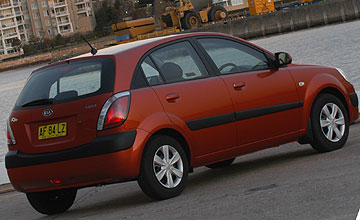BY NEIL MCDONALD | 30th Aug 2005

They were always reasonably well packaged but the driving experience always filled us with a sense of dread.
They promised so much but delivered so little in a dynamic sense.
Granted, thousands of Australians view them as perfectly acceptable budget econo-boxes for the city and for that purpose they fulfill the brief well.
Unfortunately some lagged in the areas of dynamics, tyres and in some cases build quality against the established offerings from Japan and even Europe's low-cost offerings.
But that is changing, and rather rapidly if the new Hyundai Sonata and just-launched Kia Rio is an indication.
Here are two cars that visually deliberately do not invade the senses with what could best be described as confronting style that was once the hallmark of Korean cars.
In the Rio's case we'll admit the cohesive design is largely derivative and from some angles looks distinctly European but that is not a bad thing.
Both the new Rio sedan and hatch are fresh, crisp and up-to-the-minute. The Rio is bigger, safer and has more power than the car it replaces.
The hatch is 250mm shorter overall than the old car but both models have a longer wheelbase and wider track. This translates into more secure on-road dynamics and improved interior room.
Kia claims the Rio is "best-in-class" for interior space. The sedan has 290 litres of luggage space, 29 per cent larger than the previous model.
The wheelbase is between 9mm and 40 mm longer than the VW Polo, Peugeot 206, Ford Fiesta and Holden Barina. Width and length are also up on its rivals.
In our opinion, that hatch is the pick of the pair. The five-door's steeply raked windscreen and robust C-pillar do actually give the car a sportier look. The visual impact is heightened by the distinctive wheel trims that echo alloy wheels.
Kia reckons 70 per cent of buyer will opt for the hatch. That is understandable because it looks sport and reasonably funky. Most buyers are also expected to specify the four-speed auto at $2000 and ABS is $850. The company expects to sell about 600 a month.
In real-terms Kia claims the Rio actually offers about $3500 more equipment than the previous car and it is worth bearing in mind that when it was launched five years ago it cost $14,990.
The latest Rio is one small car that will surely cause some heartburn for the more established Japanese and European fare.
Step into either the hatch or sedan and there's a harmonious, well kitted out interior. Standard equipment runs to dual airbags, air conditioning, cloth trim, power steering power windows and mirrors, six-speaker CD stereo, fore and aft cushion adjustment for the driver's seat, 60/40-split folding rear seatback, rear head restraints, driver's armrest, full-size spare, remote central locking and immobiliser. With all that kit it makes a compelling argument.
The quality feel of the switchgear and legible instruments are also worth a mention.
Power is courtesy of a new 1.6-litre four-cylinder with variable valve timing. It develops 82kW at 6000rpm and 145Nm at 4500rpm.
The visually pleasing design, equipment levels and price are all spot on but what does it drive like?
Again, we have to preface this with what we've known in the past.
This amounted to sloppy gearshift linkages, cheap-looking trim and questionable handling from some Korean vehicles but to be fair, even some other more highly fancied rivals in the sub-$20,000 price bracket have also suffered one or all of these maladies.
However, the Rio goes a long way to redress these issues and actually wins some grudging respect.
Both the 1.6-litre engine and transmission, in this case the five-speed manual, proved a good match. The shift changes was accurate, if slightly notchy, and the clutch action smooth. The shift can still be caught out but it is a vast improvement.
Driving around hilly Sydney, the 1.6-litre four proved quite spirited and revvy and could be left in higher gears without complaint. The engine was elastic enough to cope with trudging through peak hour.
Impressive too was the absence of road noise or wind noise. Triple door seals saw to that and there is a thoroughness to the car's levels of sound-deadening.
The quiet cabin - Kia claims a substantial five-decibel drop in in-car noise levels - would not have been out of place in a car costing twice the price.
The suspension largely carries over from the old car. That means competent MacPherson-style struts up front and a torsion beam rear-end and the brakes are disc/drum with the option of ABS.
Its low-cost and relatively unsophisticated but does the job. The low-speed compliance was good and the suspension even provided a degree of suppleness at highway speeds.
The rack-and-pinion steering proved commendable in the level of feedback offered and had a good turn-in.
However, the Korean-sourced tyres proved inadequate and too narrow for such a competent car.
The strong 1.6 actually enjoys being be hustled along and for a vehicle that can cope with being driven spiritedly the tyres protested when asked to power through even the most modest corners.
The tyres scrubbed and squealed for grip and as a result the steering would load up with aggressive understeer.
Kia has come so far with the Rio. The next step should be providing some good rubber.